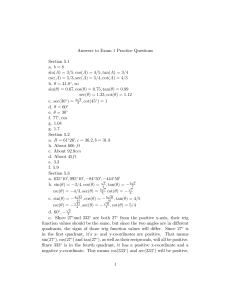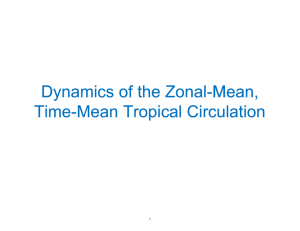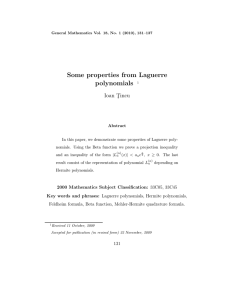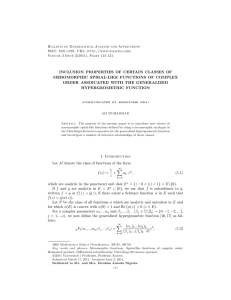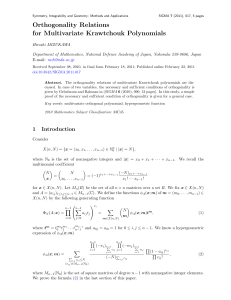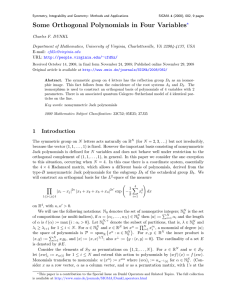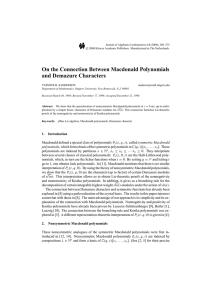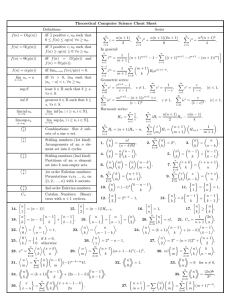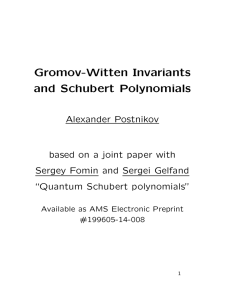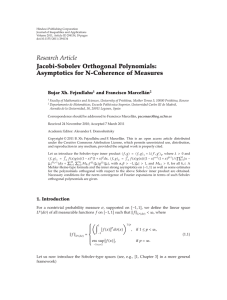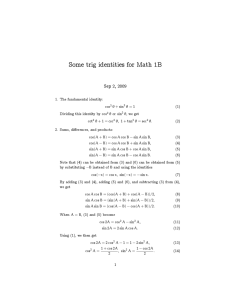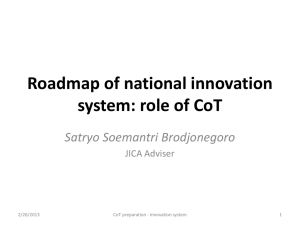ppt
advertisement
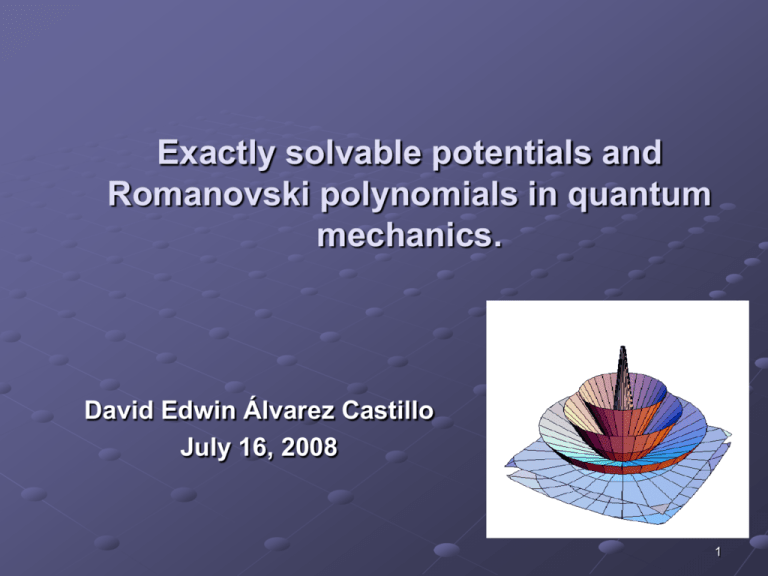
Exactly solvable potentials and Romanovski polynomials in quantum mechanics. David Edwin Álvarez Castillo July 16, 2008 1 Classical Orthogonal Polynomials •Legendre •Laguerre •Hermite •Chebyshev •Gegenbauer Adrien Marie Legendre 1752 - 1833 Edmond Nicolas Laguerre 1834 - 1886 Charles Hermite 1822-1901 •Jacobi Pafnuty Lvovich Chebyshev 1821 - 1894 Carl Gustav Jacobi Leopold Bernhard 2 Gegenbauer 1849 - 1903 Jacobi 1804 - 1851 Exactly solvable potentials in quantum mechanics 3 Hyperbolic Scarf Potential Vh (z) = a2 + (b2 ¡ a2 ¡ a®)sech2 (®z) + b(2a + ®)sech(®z)t anh(®z); 4 Solution Self-adjoint form d (¾(x)w(x)) = ¿(x)w(x) ; dx in terms of the Rodrigues formula N n dn yn (x) = [w(x)¾n (x)] : w(x) dx n 5 Real solutions in terms of Romanovski polynomials: R0(1;¡ 1) (x) = R1(1;¡ 1) (x) = R2(1;¡ 1) (x) = R3(1;¡ 1) (x) = R(1;¡ 1) (x) = 4 1 ¡ 1 ¡ 9x ¡ 6+ 16x + 56x2 16 + 84x ¡ 126x2 ¡ 210x3 20 ¡ 240x ¡ 360x2 + 480x3 + 360x4 6 7 4.3 Romanovski Polynomials and the non spherical angular functions Consider an electron in the following potential V2 (µ) V (r; µ) = V1 (r ) + ; r2 V2 (µ) = ¡ ccot (µ) ; 8 The angular equation from the SE has the solution Ãn = l (l + 1)¡ m (¡ cot (µ)) = (1 + cot (µ) 2 ) ¡ l ( l + 1) 2 e¡ l ( l + 1) t an ¡ 1 (¡ ( ) cot ( µ)) R l (l + 1) + 12 ;¡ 2l (l + 1) (¡ l (l + 1) ¡ m cot (µ)): The total wave function is Z lm (µ; ' ) = Ãn = l (l + 1)¡ (1 + cot (µ) 2 ) ¡ l ( l + 1) 2 e¡ im' = (¡ cot (µ))e m l ( l + 1) t an ¡ 1 (¡ ( ) cot ( µ) ) R l ( l + 1) + 12 ;¡ 2l ( l + 1) (¡ l (l + 1)¡ m cot (µ))ei m ' 9 Relation between the associated Legendre functions and Romanovski polynomials if c=0 (central potential) P m (cos(µ)) = const (1 + cot 2 (µ)) ¡ l l 2 R ( 0;¡ m+ l l ) (¡ cot(µ)) 10 Spherical Harmonics VS non spherical angular functions j Y 0 (µ; ' ) j 0 j Z 0 (µ; ' ) j 0 11 j Y 0 (µ; ' ) j j Z 0 (µ; ' ) j j Y 1 (µ; ' ) j j Z 1 (µ; ' ) j 1 1 1 1 12 j Y 0 (µ; ' ) j j Z 0 (µ; ' ) j j Y 1 (µ; ' ) j j Z 1 (µ; ' ) j 2 2 2 2 13 Romanovski polynomials in the trigonometric Rosen-Morse vt R M 1 (z) = ¡ 2bcot z + l(l + 1) ; sin2 (z) ² n = (n + l + 1) 2 ¡ r z= ; d b2 ( n + l + 1) 2 14 A taylor expansion shows 2b 2b l(l + 1) l(l + 1) v(z) t R M ¼ ¡ + z+ + z2 + ::: z 3 z2 15 •First term: Coulomb. •Second term: linear confinement. •Third term: standard centrifugal barrier. In this sense, Rosen-Morse I can be viewed as the image of space-like gluon propagation in coordinate space.* *Compean, Kirchbach (2006). 15 Advantages of the RMt over the Coulomb potential + lineal (QCD): •Dynamical symmetry O(4), •Exact solutions, •Good description of nucleon’s spectrum. Ãn (cot ¡ 1 x) = (1 + Cn(¡ (n+ l ) ; n2+bl ) (x) ´ x 2)¡ Rn(pn ;qn ) (x); n+ l 2 e¡ b n+ l cot ¡ 1 (x) (¡ Cn (n + l); 2b n+ l ) (x) ; 2b ; pn = (n + l ); n = 1; 2; ::: qn = ¡ n+ l 16 Baryon resonances in the traditional quark model. Circles, bricks, and triangles stand for nucleon, ¤, and ¢ states, respect ively. Di®erent colors mark di®erent SU(6)SF £ O(3)L multiplets. Noticet hestrong multiplet intertwining and t he largemass separat ion insidet hemult iplets. (Courtesy M. Kirchbach) 17 The nucleon excitation spectrum below 2 GeV. (Courtesy M. Kirchbach) 18 The ¢ excitation spectrum below 2 GeV. (Courtesy M. Kirchbach) 19 Summary The Romanovski polynomials appear as the solution of the Schrodinger equation for the Hyperbolic Scarf Potential and the Rosen-Morse trigonometric. They define new non-spherical angular functions. The Romanovski polynomials are the main designers of non--spherical angular functions of a new type, which we identified with components of the eigenvectors of the infinite discrete unitary SU(1,1) representation, ( m 0= l ( l + 1) + 1 ) (µ; ' )g. f D+ 2 j = m+ References: quant-ph/0603122 arXiv:0706.3897 quant-ph/0603232 1 2 20
